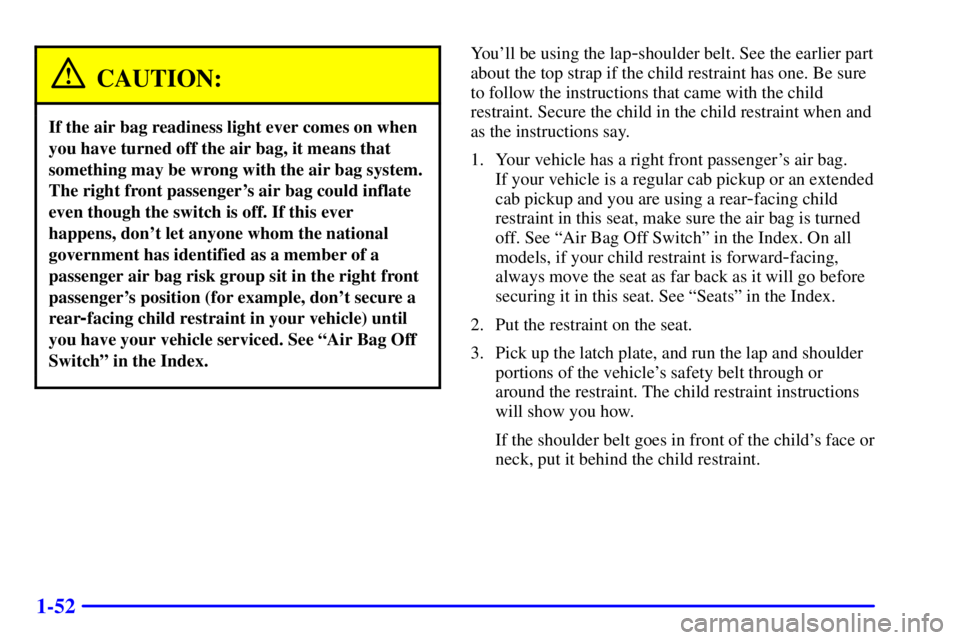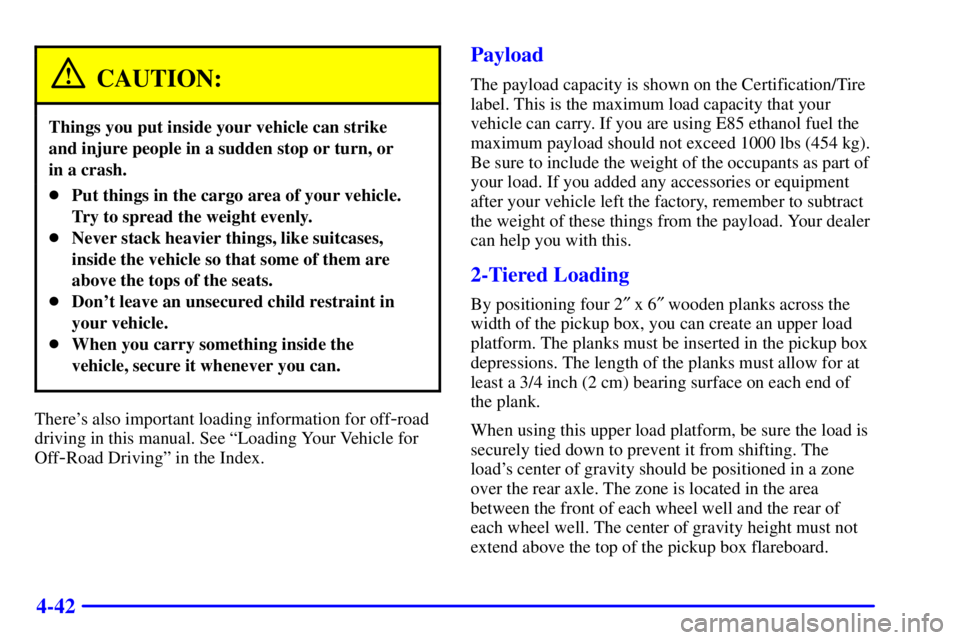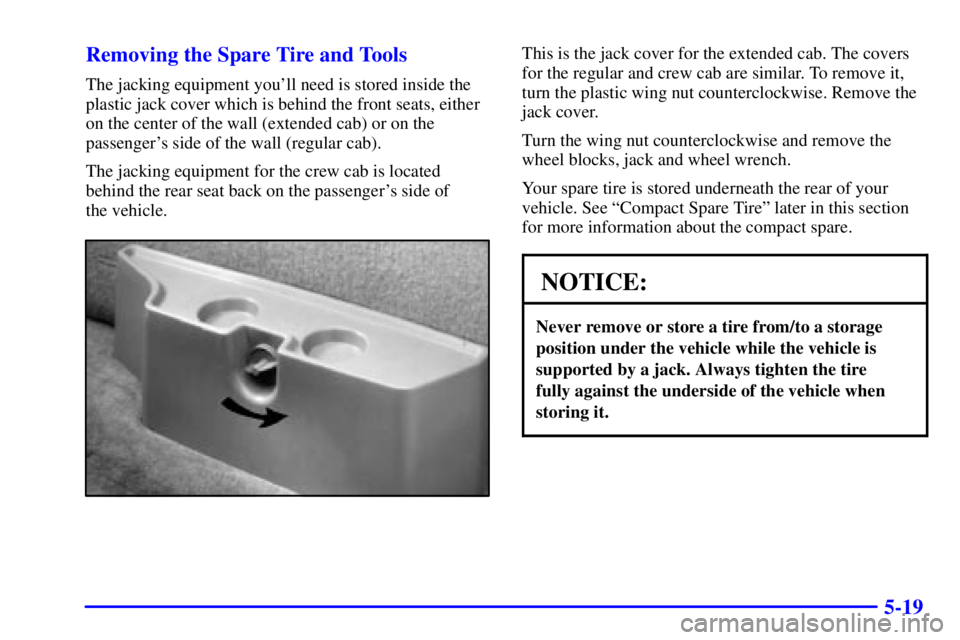Page 55 of 407
1-42
A forward-facing child seat (C-E) provides restraint for
the child's body with the harness and also sometimes
with surfaces such as T
-shaped or shelf-like shields.
A booster seat (F-G) is a child restraint designed to
improve the fit of the vehicle's safety belt system. Some
booster seats have a shoulder belt positioner, and some
high
-back booster seats have a five-point harness. A
booster seat can also help a child to see out the window.
Page 63 of 407
1-50
Jump Seats (Extended Cab)
Don't use child restraints in these positions.
The restraints won't work properly.
Securing a Child Restraint in the Right
Front Seat Position
Your vehicle has a passenger air bag. If your vehicle is a
regular cab pickup or an extended cab pickup, there's a
switch on the instrument panel that you can use to turn
off the right front passenger's air bag when you want
to secure a rear
-facing child restraint at the right front
passenger's position. See ªAir Bag Off Switchº in
the Index for more on this, including important
safety information.
Page 65 of 407

1-52
CAUTION:
If the air bag readiness light ever comes on when
you have turned off the air bag, it means that
something may be wrong with the air bag system.
The right front passenger's air bag could inflate
even though the switch is off. If this ever
happens, don't let anyone whom the national
government has identified as a member of a
passenger air bag risk group sit in the right front
passenger's position (for example, don't secure a
rear
-facing child restraint in your vehicle) until
you have your vehicle serviced. See ªAir Bag Off
Switchº in the Index.
You'll be using the lap-shoulder belt. See the earlier part
about the top strap if the child restraint has one. Be sure
to follow the instructions that came with the child
restraint. Secure the child in the child restraint when and
as the instructions say.
1. Your vehicle has a right front passenger's air bag.
If your vehicle is a regular cab pickup or an extended
cab pickup and you are using a rear
-facing child
restraint in this seat, make sure the air bag is turned
off. See ªAir Bag Off Switchº in the Index. On all
models, if your child restraint is forward
-facing,
always move the seat as far back as it will go before
securing it in this seat. See ªSeatsº in the Index.
2. Put the restraint on the seat.
3. Pick up the latch plate, and run the lap and shoulder
portions of the vehicle's safety belt through or
around the restraint. The child restraint instructions
will show you how.
If the shoulder belt goes in front of the child's face or
neck, put it behind the child restraint.
Page 68 of 407
1-55
Older Children
Older children who have outgrown booster seats should
wear the vehicle's safety belts.
If you have the choice, a child should sit next to a
window so the child can wear a lap
-shoulder belt and
get the additional restraint a shoulder belt can provide.
Q:What is the proper way to wear safety belts?
A:If possible, an older child should wear a
lap
-shoulder belt and get the additional restraint a
shoulder belt can provide. The shoulder belt should
not cross the face or neck. The lap belt should fit
snugly below the hips, just touching the top of the
thighs. It should never be worn over the abdomen,
which could cause severe or even fatal internal
injuries in a crash.
In a crash, children who are not buckled up can strike
other people who are buckled up, or can be thrown
out of the vehicle. Older children need to use safety
belts properly.
Page 131 of 407
2-60
If your vehicle has the center armrest compartment, lift
the cover to expose the storage area which includes slots
for cassettes or compact discs and a coinholder.
Some vehicles may have a storage pocket on the back of
the bucket or 60/40 bench seats.
Ashtray and Cigarette Lighter
Pull the front ashtray door down to open it.
NOTICE:
Don't put papers and other things that burn into
your ashtray. If you do, cigarettes or other smoking
materials could set them on fire, causing damage.
To remove the front ashtray, pull the bin upward.
To use the lighter, press it in all the way, and let go.
When it's ready, it will pop back out by itself.
NOTICE:
Don't hold a cigarette lighter in with your hand
while it is heating. If you do, it won't be able to
back away from the heating element when it's
ready. That can make it overload, damaging the
lighter and the heating element.
Page 158 of 407

3-6
You can direct the airflow side-to-side by moving the
thumbwheel located in the center of the vent. The vent
can be tilted up and down also. To control the amount of
airflow through the outlets, move the thumbwheel below
the vent.
Ventilation Tips
�Keep the hood and front air inlet free of ice, snow or
any other obstruction (such as leaves). The heater
and defroster will work far better, reducing the
chance of fogging the inside of your windows.
�When you enter a vehicle in cold weather, turn the
fan control to high for a few moments before driving
off. This helps clear the intake ducts of snow and
moisture, and reduces the chance of fogging the
inside of your windows.
�Keep the air path under the front seats clear of
objects. This helps air to circulate throughout
your vehicle.Audio Systems
Your audio system has been designed to operate easily
and give years of listening pleasure. You will get the
most enjoyment out of it if you acquaint yourself with it
first. Find out what your audio system can do and how
to operate all its controls, to be sure you're getting the
most out of the advanced engineering that went into it.
Setting the Clock for Systems with
SET Button
Press SET. Within five seconds, press and hold the
SEEK right arrow until the correct minute appears on
the display. Press and hold the SEEK left arrow until the
correct hour appears on the display.
Setting the Clock for Systems with HR
and MN Buttons
Press and hold HR until the correct hour appears on the
display. Press and hold MN until the correct minute
appears on the display. To display the clock with the
ignition off, press RECALL or HR/MN and the time
will be displayed for a few seconds. There is an initial
two
-second delay before the clock goes into the
time
-set mode.
Page 220 of 407

4-42
CAUTION:
Things you put inside your vehicle can strike
and injure people in a sudden stop or turn, or
in a crash.
�Put things in the cargo area of your vehicle.
Try to spread the weight evenly.
�Never stack heavier things, like suitcases,
inside the vehicle so that some of them are
above the tops of the seats.
�Don't leave an unsecured child restraint in
your vehicle.
�When you carry something inside the
vehicle, secure it whenever you can.
There's also important loading information for off-road
driving in this manual. See ªLoading Your Vehicle for
Off
-Road Drivingº in the Index.
Payload
The payload capacity is shown on the Certification/Tire
label. This is the maximum load capacity that your
vehicle can carry. If you are using E85 ethanol fuel the
maximum payload should not exceed 1000 lbs (454 kg).
Be sure to include the weight of the occupants as part of
your load. If you added any accessories or equipment
after your vehicle left the factory, remember to subtract
the weight of these things from the payload. Your dealer
can help you with this.
2-Tiered Loading
By positioning four 2, x 6, wooden planks across the
width of the pickup box, you can create an upper load
platform. The planks must be inserted in the pickup box
depressions. The length of the planks must allow for at
least a 3/4 inch (2 cm) bearing surface on each end of
the plank.
When using this upper load platform, be sure the load is
securely tied down to prevent it from shifting. The
load's center of gravity should be positioned in a zone
over the rear axle. The zone is located in the area
between the front of each wheel well and the rear of
each wheel well. The center of gravity height must not
extend above the top of the pickup box flareboard.
Page 252 of 407

5-19 Removing the Spare Tire and Tools
The jacking equipment you'll need is stored inside the
plastic jack cover which is behind the front seats, either
on the center of the wall (extended cab) or on the
passenger's side of the wall (regular cab).
The jacking equipment for the crew cab is located
behind the rear seat back on the passenger's side of
the vehicle.
This is the jack cover for the extended cab. The covers
for the regular and crew cab are similar. To remove it,
turn the plastic wing nut counterclockwise. Remove the
jack cover.
Turn the wing nut counterclockwise and remove the
wheel blocks, jack and wheel wrench.
Your spare tire is stored underneath the rear of your
vehicle. See ªCompact Spare Tireº later in this section
for more information about the compact spare.
NOTICE:
Never remove or store a tire from/to a storage
position under the vehicle while the vehicle is
supported by a jack. Always tighten the tire
fully against the underside of the vehicle when
storing it.